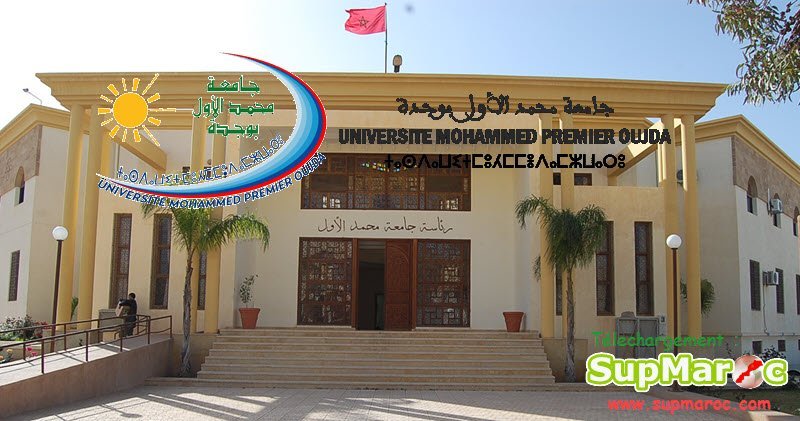La Faculté des Sciences et Techniques de Béni Mellal
Appel à Candidature
Licence Sciences et Techniques 2013-2014
CHIMIE ET GENIE DES MATERIAUX

La Faculté des Sciences et Techniques de Béni Mellal lance un appel à candidature pour la Licence Sciences et Techniques
« Chimie et Génie des Matériaux »
Conditions d’aCCès
L’accès à la Licence Sciences et Techniques «Chimie et Génie des Matériaux» est ouvert aux titulaires d’un DEUST en ‘‘Biologie Chimie Géologie’’ ou ‘‘Mathématiques Informatique Physique’’ ou équivalent.
Après étude du dossier de candidature et sélection selon des critères (diplômes, mentions, nombre d’années d’étude, notes des matières….), un concours écrit aura lieu pour les candidats retenus suite à l’étude des dossiers.
Dates à retenir
– Dépôt du dossier : avant le 01 Septembre 2013
– Résultats de présélection (via le site) : 03 Septembre 2013
– Date de confirmation par l’étudiant avant le 05 Septembre 2013 *
– Test Ecrit : 07 Septembre 2013
– Résultats définitifs : 10 Septembre 2013.
Le dossier de candidature est constitué de :
- Une demande manuscrite, mentionnant clairement les coordonnées du candidat et adressée à Monsieur le Doyen de la FST;
- Copies certifiées conformes des diplômes obtenus par le candidat (ou les attestations de réussite) ;
- Le CV du candidat ;
- Les relevés de notes des années d’études universitaires ;
- Toute pièce jugée utile pour appuyer sa candidature (lettres de recommandations, stages…) ;
- Fiche de renseignements à remplir (à téléchrger par le lien).
- Les candidats répondant aux conditions d’accès sont invités à déposer leur dossier de candidature avant le samedi 01 septembre 2013 auprès du bureau d’ordre de la FST ou à envoyer leur dossier de candidature à l’adresse suivante :
Monsieur le Coordonnateur ¨Pédagogique de LST CGM Faculté des Sciences et Techniques de Béni Mellal
BP 523, 23000 Béni Mellal Maroc
Tél: 212 05 23 48 51 12 Fax : 212 05 23 48 52 01
* N.B: Pour confirmer votre présence, veuillez contacter le responsable de la formation Tél: 0666 72 20 38 ou par e-mail : mbarki63@yahoo.fr








bonjour J’espère que vous me acceptez dans votre école
15fdece service gglooe wave me28099a le28099air fabuleux, je serais plus que ravie de pouvoir le tester, ai je toquer a la bonne porte en espc3a9rant que28099il vous reste des invit? je croise les doigtssssss pleasseeeeeeeeee! =-D31
My response:This need not be the case. R1a and pallicurarty R1a1 were probably spread into South Asia by 2 driving forces:1. Elite dominance – whereby powerful men had more wives – from the native population – and more offspring, over many generations. Like the Genshis Khan, Niall Naoighiallach phenomenon.2. R1a1 Steppe herders may very well have carried the Lactose Persistance gene (LCT), that gave them a huge nutritional advantage in a dairying economy, like that of South Asia. Here the real spread is of the LCT gene into the population, and R1a1 is just carried along for the ride!These are both very speculative explanations. AFAIK nortehrn South Asians with R1a1 apportions similar to Russia or Poland are not strong in lactase tolerance. In fact the highest concerntrations of lactase tolerance are especially in high R1b regions like the British Islands and the Basque Country, as well as in the more mixed of Northern Europe. I don’t make much sense of associating lactase tolerance with IEs or R1a1, sincerely. The « Chingis Khan phenomenon » has been seriously cricized too. I really hate this kind of hypersimplistic, populist pseudo-explanations of genetic phenomenons. Obviously all descendants of any single well described Y-DNA haplogroup have a single common male ancestor somewhere in the distant past but knowing who he was, when he lived and why his lineage happened to be so succesful is another story. You emphasize patriarchal polygyny, I rather believe more in founder effects and drift. Why do you think that the area around Denmark and Southern Sweden, was called the, « Womb of Nations » by Jordanes.Wasn’t he writing about the Germanic expansion? What’s your point? Restoring the long dead hypothesis that IEs sprung from Northern Europe as Hitler wanted to believe? Sorry but that theory is dead and buried for good. Scandinavia only became source of demic/cultural expansions of significance precisely in the Nordic Iron Age and its continuation through the Middle Ages. …not to mention the fact that milk drinking makes a warrior much taller and possibly stronger.As the Japanese case demonstrated, including milk or other dairy products in the diet has a very limited effect in size. Anyhow, most agricultural populations around the world have included milk in their diets, though often in processed forms (cheese, yogurth, curdled milk, etc.) You explain me now what’s the nutritional difference between drinking raw milk and eating cheese or yogurth, ok?Here’s more on the Germanic Expansions, which in many way is similar to the general Indo-European expansion in general.Well, the Scandinavian timeline charter is kind of bad regarding the period they call Neolithic: they make many distinctions in the Bronze and Iron Age but the big periodization interest, IMO, belongs to what they call Neolithic (including Chalcolithic), in which Scandinavia was destination for two succesive waves of migration from Eastern Europe: one from Dniepr-Don, affecting more strongly to Sweden than Denmark, and then the Corded Ware IE one that liquidated the Dolmenic culture altogether. Apart of that I see only a limited parallel with IE expansions in general. Certainly no other IE expansion sprung from Scandinavia before in any case.
bonjour
la formulaire est sous format pdf on ne peut pas la remplir veuillez déposer sous format word
et merci d’avance
OK, this book has some things going for it that help set it apart from other esircexe books out there. There are some decent footnotes and the main points all have some scientific backing behind them. It also gets bonus points for pointing out that super levels of fitness, low body fat, and big muscles do not actually equal high levels of health, longevity, and well-being. There is also truth to the author’s assertion that there is a quality of life issue involved in the time spent working out when you could be doing other things. There are a lot of other good points, too, but they are all pretty general and common sense. For example, The Big Five (or Big Three ) has been esircexe 101 for over a century because of one simple reason: there are really only 5 natural movements that the human body can reasonably perform with weights: Overhead pressing, pulling/pushing down with the lats, pushing out from the chest, pulling into the chest, and standing up to extend the legs. It’s also been long understood that the three pillars of weight training are training, diet, and rest: if you’re struggling to make gains, you should look at all three instead of just training harder, which can be potentially counterproductive. Again, this should be common sense, but it must be said nonetheless. However, for a book that’s supposed to be so predicated on science, the science that’s presented is often poorly understood or perhaps even deliberately confused to support the author’s own selling points and shortcomings of their training system. Example #1: There is no scientific evidence supporting Max Contraction, just John Little’s marketing. None. The authors’ emphasis on doing reps very slowly and counting the time spent under stress are also scientifically dubious with mixed support in the literature. Example #2: There is no scientific evidence that says old Nautilus machines are conclusively better for fitness than free weights or other manufacturors, but the authors own a gym that specializes in this equipment so it’s cited as being the ultimate in training. There is some truth to machine-based workouts being easier on certain joints, and they get bonus points in HIT because they allow you to safely go to failure without a spotter, but the authors barely reference those key points. Example #3: The studies that are cited are often sort of thrown together. Some will involve elderly or extremely out of shape clients who would have benefited greatly from the introduction of just about any physical activity. The authors point this out when the studies in question apply to aerobic esircexe as a reason not to trust those studies, but fail to keep this in mind when studies on similar parameters agree with their own conclusion. Example #4: If you look up pictures of John Little and most of his clients, you’ll mostly find a group of fairly average looking men with very few impressive physical specimens. You’d be hard pressed to tell if some of them work out at all, and I think most people at least want noticable gains from their gym experience. Little asserts time and again that success in sports and bodybuilding is mostly because of genetics and that less than 2.5% of men have the genetic potential to build large muscles. However, if you go to just about any gym with a reasonably large clientelle, you’ll see several amateur bodybuilders who show that the genetics necessary for this kind of size are not so rare, if in fact they have any special genetics at all. Little’s 12 minutes a week of max contraction disciples tend to look absolutely puny by comparison. That’s what I found most disturbing about this book: the misrepresentation of science in the book’s emphasis on genetic potential, particularly the role of genetically determined levels of myostatin as the holy grail, when it comes to building muscle. While myostatin inhibition does help produce large muscles with little bodyfat, the science simply does not say what the authors assert it does. That section is badly written, poorly researched, and misleading. For examples, the book says that professional bodybuilders refused to be tested for myostatin levels because it may harm their endorsement deals, when in fact many (such as the FREAKISH Ron Coleman, who bags millions in endorsements) were tested for a variety of genetic differences and the results usually came back that they were, in fact, fairly average. Only a couple of examples of genetic irregularities were found and those came from lesser known bodybuilders most famously, Flex Wheeler, who has extra muscle fibers. The science just didn’t find that bodybuilders are necessarily genetic freaks when looking for the things that it expected to find. But the myostatin discussion gets worse when discussing myostatin inhibition in racing whippets (and the rare, super
Why would these people, who by suntsnaece and also by today’s genetic evidence clearly could not outnumber local agriculturalists, and whose methods of transportation initially were horribly ill-adapted to the muddy, soft, wet and densely forested CE, provide these people with a new language?Because they became the aristocracy. Elite domination.Central European IEs’ history begins at Baalberge, which is a very odd Kurgan offshot in southern East Germany. There they took over a minor Danubian group, maybe in the context of intra-Danubian strife (Michelsberg vs. epi-Rf6ssen) and certainly we find clear signs of a rural aristocracy and increaed Kurganization of the burial practices (what surely implies Indoeuropeization of the natives). Baalberge expanded to the Vistula and (for a time) Northern Moravia and colonized the Brandemburgian forest. Later the resulting cultures shrunk somewhat and became strongly influenced by Danubians south of them (Boleraz-Baden), who experimented a Chalcolithic renaissance. But in the end the Danubians collapsed and the resulting culture (Vucedol) shows again clear signs of IE aristocracy rule. Simultaneously the Central European IEs expanded (Corded Ware) massively through all Central and Northern Europe and a good deal of Eastern Europe as well. The whole process took about 1000 years and was followed by another milennium of quite apparent peace at the western border of the Rhin. The lands west of it had also been taken from the Danubians by Atlantic peoples (Artenac culture, surely ancestors of historical Aquitanians). We understand poorly the details of the process but Danubian culture was over by c. 2400 BCE in any case, though obviously provided a substrate for later developements like Bell Beaker. Replacing almost all prior languages in Europe is a tough thought even if it took place during the advent of agriculture (thus my thought that it was helped by being seeded on a receptive stratum – in a well-populated region that already happened to speak similar dialects) – but without that? Unimaginable.That’s just your prejudice. Iberians or Etruscans became Romans quite easily in historical times and neither of them were Indoeuropean-speakers. Same for Sumerians becoming Semites. Elite domination works miracles: people want to climb the social escale and for that speaking the language of the elites is essential. Few languages have resisted such pressure and in most cases they had the advantage of being even more elitistic than the aristocratic elite themselves (Latin and Chinese, for a time Sumerian too). Elamites became Persians, Hellenized Anatolians became Turks, Egyptians became Arabs, Hurrians became Medes (Kurds), and a long etc.
Maju,Thanks for the links, I will give this some more thought. Again, notinhg personal, I just need something more convincing than what I have read, to date.The Kurgan hypothesis just sounds so improbably, to me. Most people think there is sufficient evidence to conclude that the (pre-Kurgan) central-European agricultural revolution did not replace the original population. Same is then even more true about any semi-nomadic steppe people entering Central Europe (CE). Why would these people, who by sustenance and also by today’s genetic evidence clearly could not outnumber local agriculturalists, and whose methods of transportation initially were horribly ill-adapted to the muddy, soft, wet and densely forested CE, provide these people with a new language? Why would such people have a superior language to that of a very entrepreneurial new local culture, in the first place? I don’t deny Kurgan expansion – I just think that these same people originally derived from or were heavily influenced by the adjacent (west and southwestern) agriculturalists who already spoke an early form of IE. Kurgans then just would be (partially) responsible for spreading the Satem shift.Replacing almost all prior languages in Europe is a tough thought even if it took place during the advent of agriculture (thus my thought that it was helped by being seeded on a receptive stratum – in a well-populated region that already happened to speak similar dialects) – but without that? Unimaginable.Giving just Kurgans an already existing IE is a much simpler explanation, IMO.Again, I agree I need to read more!
stp wach momkin ndfa3 Ihad I’écoIe bI bac
15917cTu sais qu il te faut un compte gmail ?Bon je t ai envoyc3a9 ton intoiavitn sur ton email live.fr elle te parviendra dans un dc3a9lai maxi de 6 jours.Si t as pas de compte gmail, Wave te proposera d en crc3a9er un.Bonne vague 31
Well done arcilte that. I’ll make sure to use it wisely.